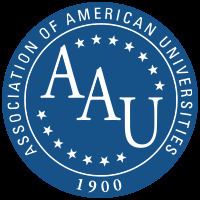Formation 1900 Membership 62 | Location United StatesCanada Website aau.edu Founded 1900 | |
 | ||
Similar Association of Public and Land, Harvard University, New York University, Massachusetts Institute of Technology, American Council on Education Profiles | ||
The Association of American Universities (AAU) is an international organization of leading research universities devoted to maintaining a strong system of academic research and education. It consists of 60 universities in the United States (both public and private) and two universities in Canada.
Contents
Organization
The AAU was founded in 1900 by a group of fourteen Ph.D.-granting universities in the United States to strengthen and standardize American doctoral programs. Today, the primary purpose of the organization is to provide a forum for the development and implementation of institutional and national policies, in order to promote strong programs in academic research and scholarship and undergraduate, graduate, and professional education.
Benefits
The largest attraction of the AAU for many schools, especially nonmembers, is prestige. For example, in 2010 the chancellor of nonmember North Carolina State University described it as "the pre-eminent research-intensive membership group. To be a part of that organization is something N.C. State aspires to." A spokesman for nonmember University of Connecticut called it "perhaps the most elite organization in higher education. You'd probably be hard-pressed to find a major research university that didn't want to be a member of the AAU." In 2012, the new elected chancellor of University of Massachusetts Amherst, a nonmember of AAU, reaffirmed the framework goal of elevating the campus to AAU standards which inspire them to become a member in the near future, and called it a distinctive status. Because of the lengthy and difficult entrance process, boards of trustees, state legislators, and donors often see membership as evidence of the quality of a university.
The AAU acts as a lobbyist at its headquarters in the city of Washington, D.C. for research and higher education funding and for policy and regulatory issues affecting research universities. The association holds two meetings annually, both in Washington. Separate meetings are held for university presidents, provosts, and other officials. Because the meetings are private they offer the opportunity for discussion without media coverage. Prominent government officials, businessmen, and others often speak to the groups.
Statistics
As of 2004, AAU members accounted for 58% of U.S. universities' research grants and contract income and 52% of all doctorates awarded in the United States. Since 1999, 43% of all Nobel Prize winners and 74% of winners at U.S. institutions have been affiliated with an AAU university. Approximately two thirds of the American Academy of Arts and Sciences 2006 Class of Fellows are affiliated with an AAU university. The faculties at AAU universities include 2,993 members of the United States National Academies (82% of all members): the National Academy of Sciences, the National Academy of Engineering, and the Institute of Medicine (2004).
Membership
AAU membership is by invitation only, which requires an affirmative vote of three fourths of current members. Invitations are considered periodically, based in part on an assessment of the breadth and quality of university programs of research and graduate education, as well as undergraduate education. The association ranks its members using four criteria: research spending, the percentage of faculty who are members of the National Academies, faculty awards, and citations. Two thirds of members can vote to revoke membership for poor rankings. As of 2010 annual dues are $80,500. All 60 US members of the AAU are also classified as Highest Research Activity (R1) Universities by the Carnegie Classification of Institutions of Higher Education.
Notes:
Former members
Advocacy
The AAU supported the Research and Development Efficiency Act (H.R. 5056; 113th Congress) arguing that the legislation "can lead to a long-needed reduction in the regulatory burden currently imposed on universities and their faculty members who conduct research on behalf of the federal government." According to the AAU, "too often federal requirements" for accounting for federal grant money "are ill-conceived, ineffective, and/or duplicative." This wastes the researchers' times and "reduces the time they can devote to discovery and innovation and increases institutional compliance costs." AAU institutions are frequently involved in U.S. science policy debates. In 2008, AAU Vice President for Policy, Tobin Smith, co-authored a textbook on U.S. science policy.
